|
Advantech PPC-L61T
Compact, industrial-grade fanless panel PC
review by Conrad H. Blickenstorfer -- photography by Carol Cotton
The Advantech PPC-L61T is a very compact representative of an interesting and important class of computers, the industrial Panel PC. Panel PCs are generally used for machine automation, process monitoring, and as control terminals, point-of-information terminals (POIs), point-of-sale terminals (POS), interactive kiosks, for gaming applications, and similar applications. They are usually configured as compact, sturdy boxes with display sizes ranging from very small to quite large, usually in the 6.5 to 19-inch range. Panel PCs are full-function PCs although most are used to do just one thing. Consequently, the application dictates size, features and performance.
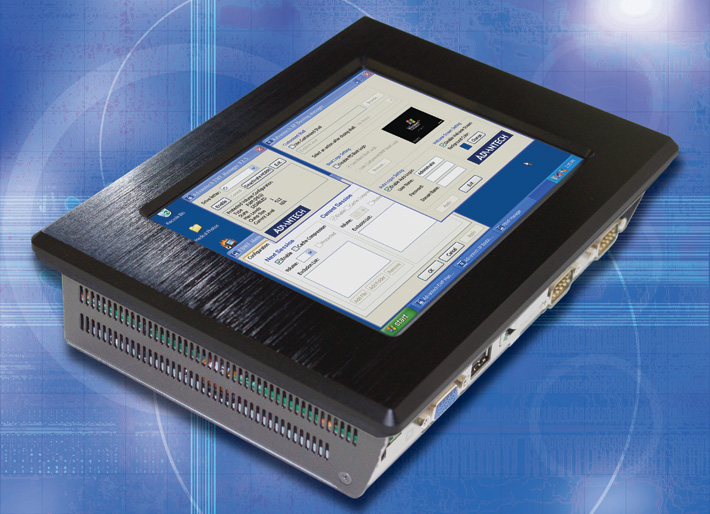
The PPC-L61T is a very small and compact panel PC. Its bezel measures just 7.9 x 5.82 inches, and the entire computer is less than two inches thick. Weight is under three pounds despite all-metal construction. The display measures 6.5 inches diagonally, uses the conventional 4:3 aspect ratio, and has an analog resistive touchscreen. Horizontal and vertical viewing angles are 120-140 degrees, wide enough for comfortable use. Viewability is augmented by anti-glare coating, and the display has a very strong 400-nit backlight.
Advantech's goal for the PPC-L61T was to create a small, inexpensive, unobtrusive panel computer that would fit into places where there's usually no room for computers. It's a device that provides just enough computing power to do the job, no more and no less. It does this with a 500MHz AMD Geode LX800 processor, up to a gigabyte of RAM, and an operating system that, depending on the application, is either running on Compact Flash or a hard disk.
Since panel PCs are often used as HMI (Human Machine Interface) systems, they must have sufficient onboard connectivity to interface with the machinery they are supposed to monitor and control. The PPC-L61T provides both current systems and legacy systems support with up to four USB 2.0 ports (two external, two internal), an RS232 serial port and a second serial port that supports RS232/422/485. There is also a VGA port for potential large/secondary screen applications, and a 10/100 Ethernet jack for communication with backend servers.
Application example for a machine like the PPC-L61T
When asked about a typical application for the PPC-L61T, Advantech provides the following example:
One of their customers is a global manufacturer that produces millions of connectors every day and distributes them to warehouses around the globe. This necessitated keeping track of millions of small, yet fairly complex, parts as well as staying on top of very tight and meticulate production and customer delivery schedules—a formidable logistical task. In an attempt at improving production efficiency and making administration simpler, they created a Human Machine Interface (HMI) system that consisted of a very compact, fanless 6.5-inch panel PC (the PPC-L60T, predecessor of the current PPC-L61T) and had a barcode scanner connected to it. The scanner is used to record production line information that is then displayed and monitored on the Panel PC's touch screen. The information is also sent to a central server via an integrated Ethernet connection.
With this solution, line operators can easily collect data and control production processes through a simple touchscreen interface. The small size, silent operation, and flexible mounting (panel mount, swing arm, stand-alone) options made it easy to integrate the Panel PC even in cramped environments, and the use of Windows XP Embedded allowed for a secure standard environment for the manufacturer's own software.
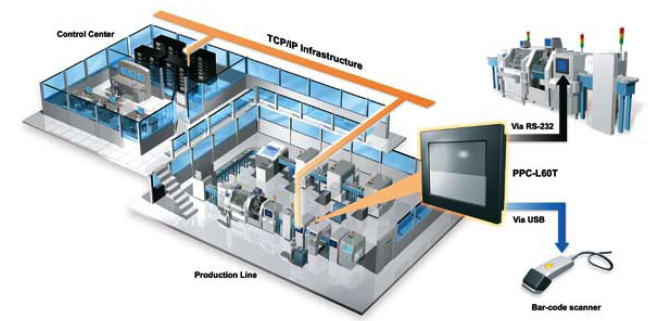
As can be seen, the requirements were quite specific:
- Small size to fit into existing factory floor setup and machinery
- Support of legacy and modern high-speed interfaces
- Touch screen operation, enough brightness, no glare
- Targeted performance (enough for the job)
- Secure standard software platform
- Ruggedness and reliable 24/7 operation
- Low cost
This new, and relatively simple, system solved the customer's problems by facilitating much better inventory control. Panel PCs are not glamorous, and they do not need to be state-of-the-art with the latest graphics cards and bleeding edge performance. The emphasis is on reliability and robustness in real-world solutions, and that is what the PPC-L61T is designed to deliver.
Choice of operating system
One of the facts of life in computing is that the operating system pretty much determines how much hardware you need. To run a current operating system such as Windows Vista at a reasonable speed, you need an amount of processing power that would have been considered in the supercomputer realm just a couple of decades ago. Yet, today it hardly seems enough to run a browser or some simple games. Industrial panel PCs do not have this problem. Since most only run a single task or application, they do not need a general purpose operating system. While the PPC-L61T can run standard Windows XP on an optional externally mounted hard disk, most customers will probably use an embedded operating system with much lower overhead.
General purpose operating systems such as Windows XP or Windows Vista are designed for general purpose computing. They come with all the drivers and software and utilities users could possibly need. As a result, they are large operating systems with numerous processes and services running all the time, consuming large amounts of memory and power.
Embedded—or "componentized"—operating systems such as Windows XP Embedded are different. They only include what is needed to perform a limited set of tasks and leave everything else behind. This greatly reduces the size of the operating system as well as the power and complexity of the hardware required to run it.
Embedded operating systems are not one-size-fits all. A manufacturer and service provider like Advantech will determine what a system is for and what tasks it should be able to perform. They then include just those components they need (there are over 10,000 available) to create a lean embedded OS platform that doesn't take much space or resources but still does sophisticated tasks like multimedia, browsing, communications or whatever a specific application requires. Essentially you get the power of Windows XP, but without any unneeded and unwanted overhead.
While most PPC-L61T customers will probably use Windows XP Embedded, Advantech also offer Windows CE 6.0. While, unlike XP Embedded, Windows CE only supports a subset of the full Windows API, it is a very compact and efficient scalable operating system with plenty of programming support. And since Windows CE's multi-threaded, multi-tasking, fully preemptive OS environment was designed from the start for hardware with extremely limited resources, Windows CE has become the OS of choice for many streamlined field and factory applications. It is possible to create a Windows CE image for just about any application, making the creation of customized software even simpler.
In general, a Windows CE-based PPC-L61T will run on just 128MB of RAM and 256MB of Flash to provide very speedy performance on the LX800 processor. An XP Embedded version will run fine on 512MB of RAM and 2GB of Flash, whereas a full Windows XP implementation will run best on a hard disk and a full gigabyte of RAM.
Enhanced Write Filter
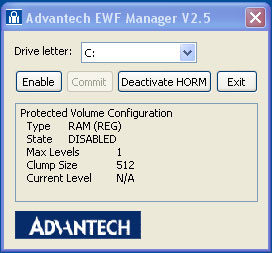 Having many years of embedded systems experience, Advantech has created a number of helper applications and utilities that help system integrators tweak their products in many ways. The PPC-L61T, for example, comes with a utility called the Enhanced Write Filter, or EWF. This is an interesting feature supported by the Windows XP Embedded operating system. Having many years of embedded systems experience, Advantech has created a number of helper applications and utilities that help system integrators tweak their products in many ways. The PPC-L61T, for example, comes with a utility called the Enhanced Write Filter, or EWF. This is an interesting feature supported by the Windows XP Embedded operating system.
What the Enhanced Write Filter does is provide the ability to write-protect a run-time image. It does that by redirecting write operations to another storage location and totally write-protects the run-time image, thus preventing any damage that might be caused by an unexpected power failure, vibration or even a virus attack.
Taking full advantage of EWF technology requires some studying and proper configuration of a system. To learn more about this particular feature of XP Embedded, read the Enhanced Write Filter section at the Microsoft Embedded Developer Center.
FBWF Manager
 FBWF stands for "File Based Write Filter," and it is another tool for embedded systems developers to quickly prototype and integrated file-based write filters. FBWF is used to provide the appearance of read and write access to write-sensitive or read-only storage and makes read and write access transparent to applications. What FBWF does is write to a cache instead of media that is not supposed to be altered or written on. As such, FBWF acts a bit like EWF, but it's more powerful and there are more features. FBWF stands for "File Based Write Filter," and it is another tool for embedded systems developers to quickly prototype and integrated file-based write filters. FBWF is used to provide the appearance of read and write access to write-sensitive or read-only storage and makes read and write access transparent to applications. What FBWF does is write to a cache instead of media that is not supposed to be altered or written on. As such, FBWF acts a bit like EWF, but it's more powerful and there are more features.
Being a command line tool, the File Based Write Filter manager offers more than a dozen command line switches, making both for a powerful tool, and something else to remember. That's why Advantech included a FBWF Manager software panel that allows precise session as cache configuration down to the directory and file level.
(To learn more about this particular feature of XP Embedded, read the File-Based Write Filter section at the Microsoft Embedded Developer Center.
That said, let's take a look at this interesting machine.
Rational design
Just because a panel computer is a tool for utilitarian jobs does not mean it cannot benefit from good industrial design, and the PPC-L61T is an excellent example. The picture below shows the computer from the front and all four sides. The thick front bezel consists of a thick, beveled aluminum plate with an elegant black semi-gloss horizontal brush finish. The housing itself is all steel, painted black. There are cooling slots, but no fan, so the device runs silent.
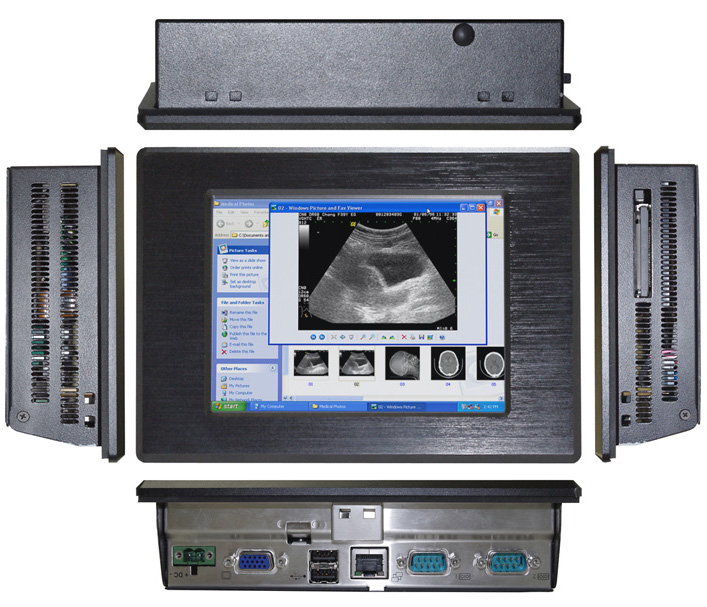
Looking at the four sides, all connectivity is concentrated along the bottom side, facing down. The sole interface not on the bottom is the Compact Flash slot located on the right side.
 The inside of this little panel PC is as crisp and clean as it gets. Unlike notebook computers where things can get quite cramped and chaotic due to the need to pack a multitude of components (mother and daughter boards, battery, disk drive, optical drive, etc.) into a very cramped space inside a device that needs to be as light and slim as possible, panel PCs are totally straight-forward. They are small rectangular boxes. Weight and thickness doesn't matter all that much, and generally neither does the location of ports. There must be some temptation to cut corners and not spend too much time in optimizing things, but from the looks of it, simply doing a quick and dirty job never entered the Advantech engineers' minds. Just take a look at how neat the layout is: The inside of this little panel PC is as crisp and clean as it gets. Unlike notebook computers where things can get quite cramped and chaotic due to the need to pack a multitude of components (mother and daughter boards, battery, disk drive, optical drive, etc.) into a very cramped space inside a device that needs to be as light and slim as possible, panel PCs are totally straight-forward. They are small rectangular boxes. Weight and thickness doesn't matter all that much, and generally neither does the location of ports. There must be some temptation to cut corners and not spend too much time in optimizing things, but from the looks of it, simply doing a quick and dirty job never entered the Advantech engineers' minds. Just take a look at how neat the layout is:
What you see here is the functionality of a full-size motherboard condensed into a board measuring less than 7 x 4.5 inches, sitting inside a box about that size. There is not a tenth of an inch of wasted space. Yet, despite the small size, everything is neatly accessible. Open six Philips screws to take the back off and you have full, unobstructed access to the front side of the board with its 200-pin memory slot, mini-PCI connector, and IDE connector. Like on full-size desktop motherboards, there are also additional connectors that you may or may not use. Examples are a speaker connector, audio in and out connectors, and a microphone connector. Like many ultra-compact motherboards, this one has components on both sides.
Getting to the backside of the board is a bit more difficult, but it's just a matter of undoing a few more screws and lifting the board out. On the back side you can see the AMD LX800 processor, CS5536AD chipset, as well as the board's CF Card slot and LVDS (Low Voltage Differential Signaling) connector.
Touch panel
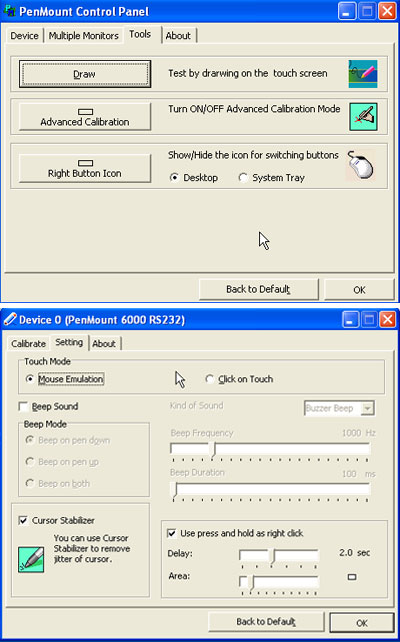 The Advantech PPC-L61T uses an analog resistive touchscreen with a serial interface. It uses the PenMount 6000 Controller Chipset. The touch screen itself is a heavy-duty unit that is rated at ten million depressions. The resistive touch screen can be operated either with any stylus or with a finger. Like the touch screens used in other Advantech products, this one is very smudge-resistant, a quality that's much appreciated in daily use. The Advantech PPC-L61T uses an analog resistive touchscreen with a serial interface. It uses the PenMount 6000 Controller Chipset. The touch screen itself is a heavy-duty unit that is rated at ten million depressions. The resistive touch screen can be operated either with any stylus or with a finger. Like the touch screens used in other Advantech products, this one is very smudge-resistant, a quality that's much appreciated in daily use.
The unit comes with a PenMount Control Panel that let's you calibrate the touchscreen using 4, 9, 16, or 25 points, with 25 points offering maximum accuracy. A "Draw" mode provides digitizer statistics and can be used for debugging. An option menu lets you set the operation mode either to stream mode or point mode.
The control panel has a special screen for edge compensation. Edge compensation can be very important for precise calibration. With touch screens and digitizers it can be difficult to touch or select items at the edge of the panel, especially when the display runs all the way to the kind of thick protective bezel most rugged panels have. The L61T's panel allows you to precisely define edge compensation for all four sides, i.e., set it so the cursor thinks the edge is either farther away or closer in. Precise configuration can make for optimal usability and responsiveness in touch applications.
In the panel's Setting menu you can configure touch mode to work either in mouse emulation or to simply issue a click on touch. You can also enable press-and-hold for right mouse clicks and fine-tune right mouseclick operation, setting both the delay and the size of the click area.
You can also enable a beep sound to occur on pen down or pen up (or both), and even set its frequency and duration. This may sound strange, but in noisy shop floor operation, having auditory feedback to confirm a touch operation may come in handy.
In applications that use multiple monitors, the PenMount Control panel let's you configure multiple monitor support and map the touch screens.
Why is all of this important? Because having the proper tools to precisely configure a touch screen for an application can make or break its utility and usability. And with touch screen vendors now adding multi-touch/multi-finger operation, this will only become more important.
Display
Per its specs and manual, the PPC-L61T's 6.5-inch display size is supposed to have a 640 x 480 pixel maximum resolution, which makes sense on a display of that size. Somehow, the display in our review unit was able to run at 800 x 600 and even 1024 x 768 pixel resolution without any problems while 640 x 480 was not available in the Windows Display control panel. At the higher resolutions, the display isn't all that sharp, and 640 x 480 would probably be better.
The 140 degree horizontal viewing angle means that the display remains easily viewable. The vertical viewing angle is 120 degrees, which is still good, but there are color and luminance shifts.
While this is not considered an outdoor viewable display, its 400 nits brightness and excellent anti-glare properties make it usable in a wide range of lighting conditions.
Power
The PPC-L61T does not have a battery and runs on external power instead. It comes with a 19 Volt/3.2A power adapter and can handle input voltages ranging from 12 to 30 Volt DC, 2.5A Max..
The device is APM 1.2 compliant. Power saving modes depend the operating system. Our XP Embedded test machine supported the usual Normal/Standby/Suspend modes.
Wireless and other expansion
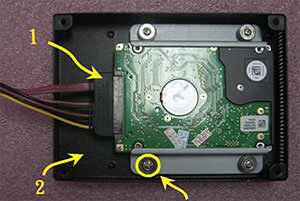 The Advantech PPC-L61T does not come with any integrated or onboard wireless capabilities. It can, however, be equipped with a 802.11a/b/g mini-PCI WiFi module. Bluetooth is not specifically listed, but mini-PCI Bluetooth modules are readily available and I presume they'd work just fine with this panel PC. The Advantech PPC-L61T does not come with any integrated or onboard wireless capabilities. It can, however, be equipped with a 802.11a/b/g mini-PCI WiFi module. Bluetooth is not specifically listed, but mini-PCI Bluetooth modules are readily available and I presume they'd work just fine with this panel PC.
As far as hard disks go, there is an optional Extension HDD kit for the PPC-L61T. It is a nicely designed kit that includes a shock-absorbing mounting bracket for a 2.5-inch hard disk, a SATA cable and SATA-to-IDE converter, all housed in a special enclosure that screws onto the back of the computer.
In units with hard disks, the CF Card slot is not used and is presumably available for other purposes.
Ruggedness
As a panel PC, the Advantech PPC-L61T addresses ruggedness in a different way from a mobile computer. Since it will be installed in a panel or other stationary setting, it won't be dropped. And since it is most likely used indoors, it won't get rained on. However, it is expected to run reliably 24/7 in factory settings where temperature, vibration, and exposure to water still can be issues.
As a result, the PPC-L61T is sturdy and very well built. The thick aluminum front bezel will not flex or break. When mounted in a panel, a thick neoprene gasket behind the bezel lip effectively seals the computer. So while the steel body itself has ventilation slots and standard connectors, from the front the system carries the equivalent of IP65 sealing. This means that a panel with the PPC-L61T installed could be housed down and not incur any damage.
In terms of operating temperature, shop floors are not freezers, and so the device is designed to operate within a range of 32 to 122 degrees Fahrenheit and 10 to 95% humidity.
Since manufacturing equipment may vibrate, Advantech tested the PPC-L61T and found that Compact Flash systems can handle 3G RMS random vibration 5-500Hz, and hard disk systems 1G in the same test. They also conducted a shock test and certify the computer to 10G peak acceleration for a duration of 11 msec.
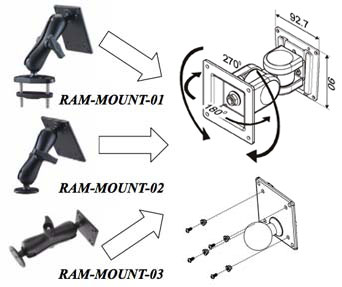 Panel computers like the Advantech PPC-L61T may encounter a variety of different mounting requirements, and therefore a need for different mounting kits and modules. The computer comes with a standard panel mount kit, but since the backplate has standard VESA mount screw holes, there are any number of different mounting options. Panel computers like the Advantech PPC-L61T may encounter a variety of different mounting requirements, and therefore a need for different mounting kits and modules. The computer comes with a standard panel mount kit, but since the backplate has standard VESA mount screw holes, there are any number of different mounting options.
The picture to the right shows some of these possibilities. Advantech offers three different types of RAM-MOUNT kits from National Products. National Products' patented RAM-MOUNT solutions are the undisputed industry leader with their unique rubber ball and connector arm system that makes for unparalleled flexibility and near total absence of vibration.
To change the viewing angle, you simply loosen the large, grippy control knob, get the unit into the proper position, and tighten it. Mounting plates are all industry standard.
Advantech also offers the PPC-174 WL-MT wall mount kit shown in the upper right of the picture.
Bottom line
The Advantech PPC-L61T is a very compact ruggedized industrial panel-mount computer from an experienced Taiwanese embedded and industrial systems manufacturer with a worldwide presence. Its anodized aluminum and steel housing is very solid and was designed for operation in demanding industrial settings.
 The PPC-L61T can be configured either as an embedded device running Windows XP Embedded or Windows CE 6.0 on Compact Flash, or as a full Windows XP machine using an optionally available SATA hard disk kit that mounts onto the backside of the computer. The unit is powered by an AMD Geode LX800 processor and comes with up to a gigabyte of RAM. The low-power processor provides adequate performance and does not need a fan. When mounted in a panel, the PPC-L61T's front bezel is sealed to IP65 specifications. The unit is designed to handle the abuse (shock, temperature, vibration, etc.) likely encountered in a manufacturing environment. The PPC-L61T can be configured either as an embedded device running Windows XP Embedded or Windows CE 6.0 on Compact Flash, or as a full Windows XP machine using an optionally available SATA hard disk kit that mounts onto the backside of the computer. The unit is powered by an AMD Geode LX800 processor and comes with up to a gigabyte of RAM. The low-power processor provides adequate performance and does not need a fan. When mounted in a panel, the PPC-L61T's front bezel is sealed to IP65 specifications. The unit is designed to handle the abuse (shock, temperature, vibration, etc.) likely encountered in a manufacturing environment.
Advantech offers panel computers with a wide variety of screen sizes. The compact L61T with its small 6.5-inch display is designed to fit into tight spaces. The optional resistive touch screen is very responsive and highly configurable for optimal use with both a stylus or fingers. It also has much appreciated antiglare treatment.
The PPC-L61T offers good onboard connectivity for use with a variety of current or legacy devices and peripherals. You get two internal and two external USB 2.0 USB ports, RS232 and RS232/422/485 serial, video for an external monitor, and LAN. There is also CF Card slot (used for the OS in non-HD systems) and an internal mini-PCI slot that can be used for wireless and other modules.
The PPC-L61T is a cleanly designed and very compact panel computer that combines excellent industrial design, ruggedness, easy customization and maintenance, and targeted performance. It can be configured for a large variety of applications in all kinds of manufacturing and industrial settings, with application in numerous other settings as well.
-- Conrad H. Blickenstorfer
Advantech PPC-L61T Specs:
| Type |
Rugged industrial-grade fanless panel computer
|
| OS |
Windows XP, Windows XP Embedded, Windows CE 6.0
|
| Processor |
AMD Geode LX800
|
| Clock speed |
500MHz
|
| Chipset |
Integrated in AMD CS5536AD South Bridge
|
| Memory |
Up to 1GB DDR 333/400 SDRAM in one 200-pin socket |
| Display |
6.5" VGA (640 x 480) color TFT with 140/120 degrees viewing angle, anti-glare coating, and 400 nit backlight
|
| Digitizer |
Optional analog resistive touch screen with PenMount 6000 Controller and 80% light transmission |
| Keyboard |
Optional external USB |
| Storage |
CF-based Flash (also supports shock-mounted extension HDD kit with IDE-based 2.5-inch SATA HDD)
|
| Expansion slots |
1 internal Mini-PCI Type III, CF Card for flash
|
| Housing |
Heavy anodized aluminum bezel, metal case, with VESA-standard RAM mounting |
| Size (inches) |
7.9 x 5.82 x 1.9 |
| Weight |
2.85 lbs.
|
| Operating temperature |
32 to 122 degree Fahrenheit |
| Ingress protection |
IP65 (front bezel) |
| Shock |
10G peak acceleration (11 ms duration) |
| Vibration |
1G RMS (operating with HDD); 3G RMS (operating with CF card) |
| EMC |
CE, FCC, CCC, BSMI, VCCI 6786 |
| Safety |
UL, CE; CCC, CB. BSMI |
| Humidity |
10-95% at 104 degrees Fahrenheit, non-condensing |
| Power |
12-30 Volt DC |
| Interface |
External: 2 USB 2.0, 1 RS-232/422/485, 1 RS-232, RJ45 LAN (10/100); internal: 2 USB 2.0, audio in/out, VGA |
| Wireless options |
Flexible expansion capability for MiniPCI 802.11b/g WiFi, GPS, GSM/GPRS
|
| Price |
Starting at US$900 |
| Contact |
Advantech www.advantech.com.tw |
(copyright 2009 RuggedPCReview.com)
Advantech Corporation
38 Tesla, Suite 100
Irvine, CA 92618
Toll Free: 1-800-866-6008
Ph: 949-789-7178
Fax: 949-789-7179
ECGInfo@advantech.com
www.advantech.com
Advantech Co. Ltd.
No.1, Alley 20, Lane 26, Rueiguang Road
Neihu District, Taipei Taiwan 114, R.O.C.
Tel: 886-2-2792-7818
Fax: 886-2-2794-7301
www.advantech.com
|



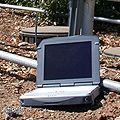


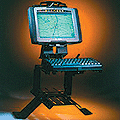







 Having many years of embedded systems experience, Advantech has created a number of helper applications and utilities that help system integrators tweak their products in many ways. The PPC-L61T, for example, comes with a utility called the Enhanced Write Filter, or EWF. This is an interesting feature supported by the Windows XP Embedded operating system.
Having many years of embedded systems experience, Advantech has created a number of helper applications and utilities that help system integrators tweak their products in many ways. The PPC-L61T, for example, comes with a utility called the Enhanced Write Filter, or EWF. This is an interesting feature supported by the Windows XP Embedded operating system.
 FBWF stands for "File Based Write Filter," and it is another tool for embedded systems developers to quickly prototype and integrated file-based write filters. FBWF is used to provide the appearance of read and write access to write-sensitive or read-only storage and makes read and write access transparent to applications. What FBWF does is write to a cache instead of media that is not supposed to be altered or written on. As such, FBWF acts a bit like EWF, but it's more powerful and there are more features.
FBWF stands for "File Based Write Filter," and it is another tool for embedded systems developers to quickly prototype and integrated file-based write filters. FBWF is used to provide the appearance of read and write access to write-sensitive or read-only storage and makes read and write access transparent to applications. What FBWF does is write to a cache instead of media that is not supposed to be altered or written on. As such, FBWF acts a bit like EWF, but it's more powerful and there are more features.

 The inside of this little panel PC is as crisp and clean as it gets. Unlike notebook computers where things can get quite cramped and chaotic due to the need to pack a multitude of components (mother and daughter boards, battery, disk drive, optical drive, etc.) into a very cramped space inside a device that needs to be as light and slim as possible, panel PCs are totally straight-forward. They are small rectangular boxes. Weight and thickness doesn't matter all that much, and generally neither does the location of ports. There must be some temptation to cut corners and not spend too much time in optimizing things, but from the looks of it, simply doing a quick and dirty job never entered the Advantech engineers' minds. Just take a look at how neat the layout is:
The inside of this little panel PC is as crisp and clean as it gets. Unlike notebook computers where things can get quite cramped and chaotic due to the need to pack a multitude of components (mother and daughter boards, battery, disk drive, optical drive, etc.) into a very cramped space inside a device that needs to be as light and slim as possible, panel PCs are totally straight-forward. They are small rectangular boxes. Weight and thickness doesn't matter all that much, and generally neither does the location of ports. There must be some temptation to cut corners and not spend too much time in optimizing things, but from the looks of it, simply doing a quick and dirty job never entered the Advantech engineers' minds. Just take a look at how neat the layout is:
 The Advantech PPC-L61T uses an analog resistive touchscreen with a serial interface. It uses the PenMount 6000 Controller Chipset. The touch screen itself is a heavy-duty unit that is rated at ten million depressions. The resistive touch screen can be operated either with any stylus or with a finger. Like the touch screens used in other Advantech products, this one is very smudge-resistant, a quality that's much appreciated in daily use.
The Advantech PPC-L61T uses an analog resistive touchscreen with a serial interface. It uses the PenMount 6000 Controller Chipset. The touch screen itself is a heavy-duty unit that is rated at ten million depressions. The resistive touch screen can be operated either with any stylus or with a finger. Like the touch screens used in other Advantech products, this one is very smudge-resistant, a quality that's much appreciated in daily use.
 The Advantech PPC-L61T does not come with any integrated or onboard wireless capabilities. It can, however, be equipped with a 802.11a/b/g mini-PCI WiFi module. Bluetooth is not specifically listed, but mini-PCI Bluetooth modules are readily available and I presume they'd work just fine with this panel PC.
The Advantech PPC-L61T does not come with any integrated or onboard wireless capabilities. It can, however, be equipped with a 802.11a/b/g mini-PCI WiFi module. Bluetooth is not specifically listed, but mini-PCI Bluetooth modules are readily available and I presume they'd work just fine with this panel PC.
 Panel computers like the Advantech PPC-L61T may encounter a variety of different mounting requirements, and therefore a need for different mounting kits and modules. The computer comes with a standard panel mount kit, but since the backplate has standard VESA mount screw holes, there are any number of different mounting options.
Panel computers like the Advantech PPC-L61T may encounter a variety of different mounting requirements, and therefore a need for different mounting kits and modules. The computer comes with a standard panel mount kit, but since the backplate has standard VESA mount screw holes, there are any number of different mounting options.
 The PPC-L61T can be configured either as an embedded device running Windows XP Embedded or Windows CE 6.0 on Compact Flash, or as a full Windows XP machine using an optionally available SATA hard disk kit that mounts onto the backside of the computer. The unit is powered by an AMD Geode LX800 processor and comes with up to a gigabyte of RAM. The low-power processor provides adequate performance and does not need a fan. When mounted in a panel, the PPC-L61T's front bezel is sealed to IP65 specifications. The unit is designed to handle the abuse (shock, temperature, vibration, etc.) likely encountered in a manufacturing environment.
The PPC-L61T can be configured either as an embedded device running Windows XP Embedded or Windows CE 6.0 on Compact Flash, or as a full Windows XP machine using an optionally available SATA hard disk kit that mounts onto the backside of the computer. The unit is powered by an AMD Geode LX800 processor and comes with up to a gigabyte of RAM. The low-power processor provides adequate performance and does not need a fan. When mounted in a panel, the PPC-L61T's front bezel is sealed to IP65 specifications. The unit is designed to handle the abuse (shock, temperature, vibration, etc.) likely encountered in a manufacturing environment.